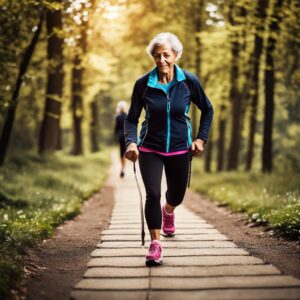As we age, maintaining good joint health becomes increasingly important. Our joints, which connect bones and allow movement, can experience wear and tear over time. However, there’s a simple and accessible solution: walking for joint health. Walking is not only a low-impact exercise but also an excellent way to support joint health, especially for those over 50. In this article, we’ll explore the benefits of walking, practical tips, and how to incorporate it into your daily routine.
The Importance of Walking for Joint Health
1. Low-Impact Exercise
Walking emerges as a beacon of low-impact exercise, offering a gentle yet effective way to nurture joint health. Unlike high-impact activities such as running or intense aerobics, walking imposes minimal stress on the joints, fostering movement without exacerbating wear and tear.
2. Strengthening Muscles
Engaging in regular walking sessions not only benefits the cardiovascular system but also strengthens the surrounding muscle groups. By fortifying muscles, particularly those supporting the joints, individuals can enhance stability and reduce the risk of injury.
3. Enhanced Circulation
The rhythmic motion of walking stimulates blood flow throughout the body, including the joints. Improved circulation facilitates the delivery of vital nutrients and oxygen to these areas, promoting repair and mitigating inflammation—an integral aspect of joint health.
4. Weight Management
Maintaining a healthy weight is paramount for joint health, as excess weight places undue strain on the joints, particularly the knees and hips. Walking serves as a formidable ally in weight management, aiding in calorie expenditure and fostering overall fitness levels.
Tips for Effective Walking for Joint Health
1. Optimal Footwear Selection
Investing in supportive walking shoes tailored to your foot type is essential. Prioritize features such as cushioning, arch support, and proper sizing to mitigate discomfort and safeguard joint integrity.
2. Pre- and Post-Walk Rituals
Embark on your walking journey with preparatory warm-up exercises to prime your muscles and joints for activity. After completing your walk, indulge in cooling-down stretches to alleviate tension and prevent stiffness.
3. Mindful Posture Maintenance
Conscious attention to posture while walking is pivotal. Maintain an upright stance, relaxed shoulders, and aligned spine to minimize undue stress on the back and joints.
4. Gradual Progression Strategy
Adopt a gradual approach to increasing walking duration and intensity, prioritizing consistency over rapid advancement. Listen to your body’s cues and adjust your regimen accordingly to prevent overexertion and potential joint strain.
Integrating Walking for Joint Health into Daily Life
1. Setting Attainable Objectives
Establish realistic walking goals tailored to your fitness level and lifestyle constraints. Strive for regularity by incorporating brisk walks into your daily routine, whether as standalone sessions or integrated into errands and activities.
2. Strategic Scheduling Tactics
Infuse creativity into your daily schedule by identifying opportunities for walking, be it during commute routes, strolls, or social outings. Embrace alternatives to vehicular transport, such as walking or cycling, to maximize physical activity engagement.
3. Social Engagement Enhancements
Elevate the walking experience by inviting companionship, whether through bonding with friends or engaging in group walks. Leverage social connections to infuse motivation and enjoyment into your walking endeavors.
4. Nature Immersion
Embrace the rejuvenating allure of natural landscapes by selecting scenic routes for your walks. Parks, trails, and green spaces offer a serene backdrop conducive to physical and mental well-being enhancement.
Addressing Joint Discomfort with Holistic Strategies
1. Vigilant Self-Monitoring
Remain attuned to any signs of joint discomfort during walking sessions and modify your approach accordingly. Explore alternative low-impact activities to diversify your fitness regimen while safeguarding joint health.
2. Seek Professional Advice
In cases of persistent or escalating joint pain, consulting a healthcare professional is paramount. Receive personalized guidance and recommendations tailored to your unique needs and circumstances to optimize joint health management.
3. Holistic Support Integration
Augment your walking regimen with complementary therapies such as massage, acupuncture, or yoga to amplify joint health benefits. Consider the inclusion of joint health supplements (such as glucosamine or omega-3 fatty acids) with your doctor. While walking is beneficial, supplements can complement your efforts. under professional supervision to bolster overall efficacy.
You could try Joint Genesis, which helps relieve any joint discomfort.
Remember that taking a holistic approach to wellness involves addressing the physical, emotional, and spiritual aspects of health.
Embracing a Holistic Wellness Paradigm
In conclusion, walking stands as an indispensable cornerstone of joint health maintenance, particularly for individuals navigating the golden years of life. By embracing the multifaceted benefits of walking and adopting a holistic wellness approach, individuals can cultivate resilience, vitality, and longevity in their joint health journey.
Remember to consult with a healthcare professional before starting any new exercise program, especially if you have existing joint issues. Happy walking!
Certainly! Maintaining joint health during menopause is crucial for overall well-being. Alongside walking, consider incorporating the following exercises into your routine:
- Swimming and Water Aerobics:
- Water provides buoyancy, reducing the impact on joints.
- Swimming and water aerobics improve cardiovascular fitness and strengthen muscles without stressing joints.
- Cycling (Stationary or Outdoor):
- Cycling is a low-impact exercise that engages leg muscles and supports joint mobility.
- Stationary bikes or outdoor cycling are excellent options.
- Tai Chi and Yoga:
- Both Tai Chi and yoga focus on gentle movements, balance, and flexibility.
- They promote relaxation, reduce stress, and enhance joint function.
- Resistance Training (Strength Training):
- Use resistance bands or light weights to strengthen muscles around joints.
- Strengthening helps stabilize joints and reduces the risk of injury.
- Pilates:
- Pilates emphasizes core strength, posture, and alignment.
- It targets deep muscles, supporting joint stability.
- Stretching and Flexibility Exercises:
- Regular stretching improves joint range of motion and prevents stiffness.
- Include dynamic stretches before exercise and static stretches afterward.
- Low-Impact Dance (Zumba, Barre):
- Dance-based workouts provide cardiovascular benefits without excessive joint stress.
- Zumba and barre classes are fun options.
- Rowing (Indoor or Outdoor):
- Rowing engages multiple muscle groups, including those around the shoulders, hips, and knees.
- It’s a full-body workout with minimal impact.
- Gentle Aerobics Classes:
- Look for low-impact aerobics classes designed for older adults.
- These classes combine movement, music, and social interaction.
- Balance and Stability Exercises:
- Focus on balance to prevent falls and protect joints.
- Try single-leg stands, heel-to-toe walking, or balance boards.
Remember to consult with a healthcare provider or a fitness professional before starting any new exercise program. They can tailor recommendations based on your individual needs and joint health.
I actually had a huge breakthrough in my post-40 strength training, thanks to a product I stumbled upon called Joint Genesis I had no idea it existed. I have gradually become fitter, and my joints no longer ache. I highly recommend it!





